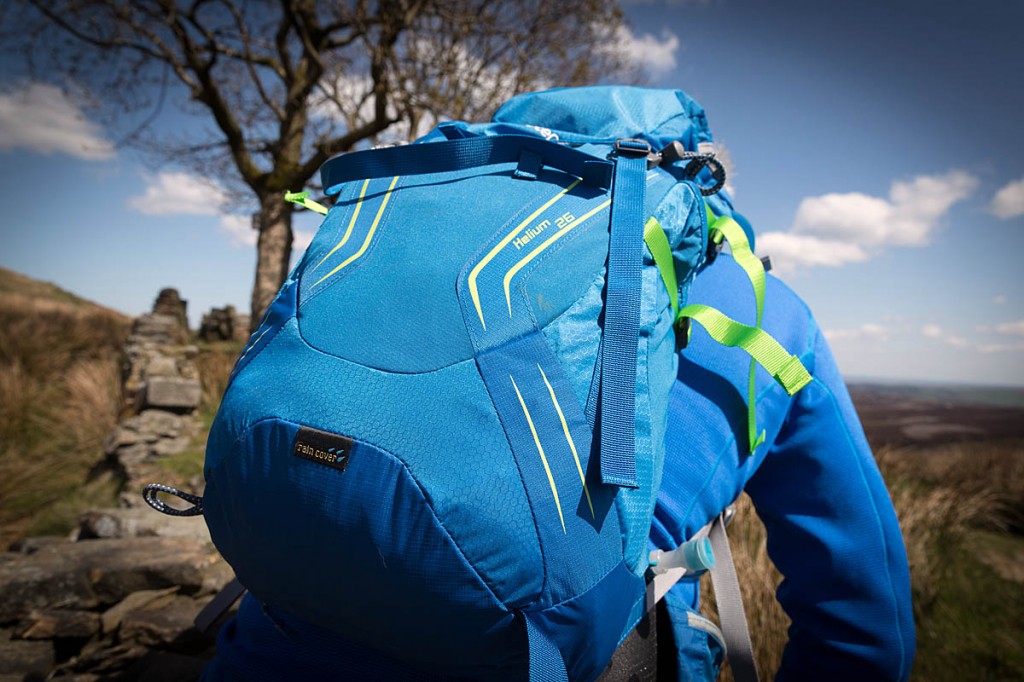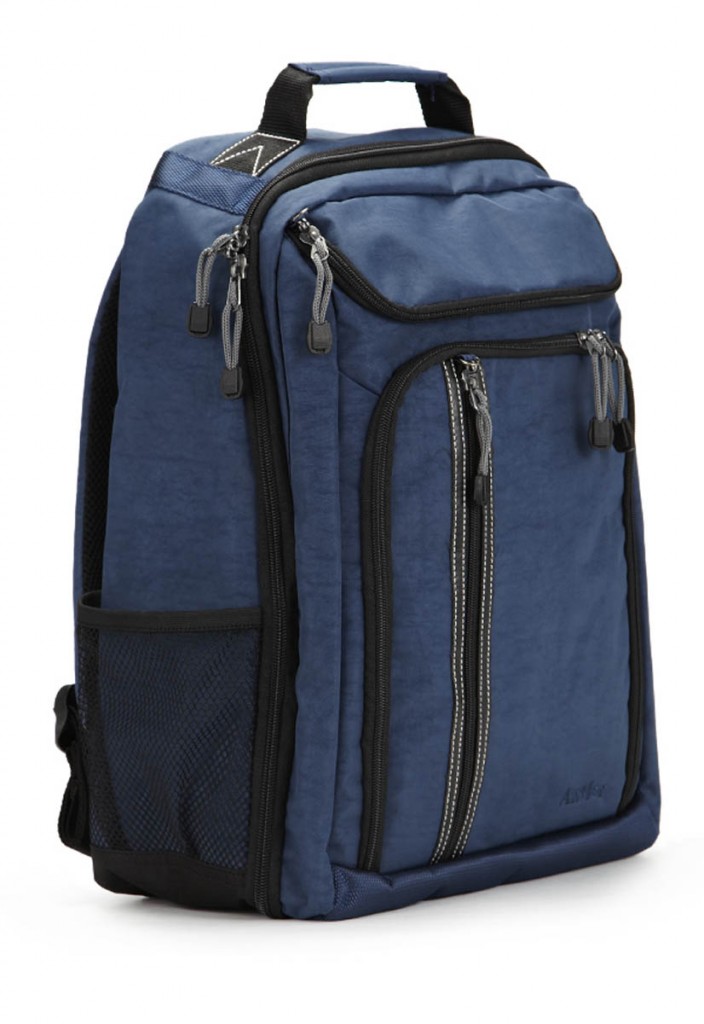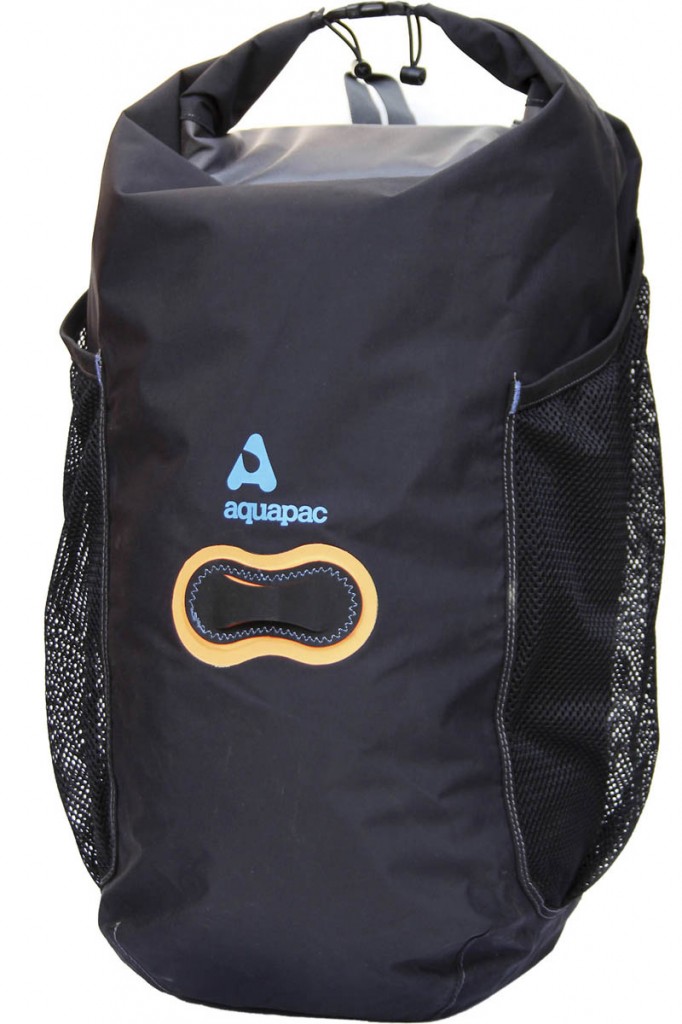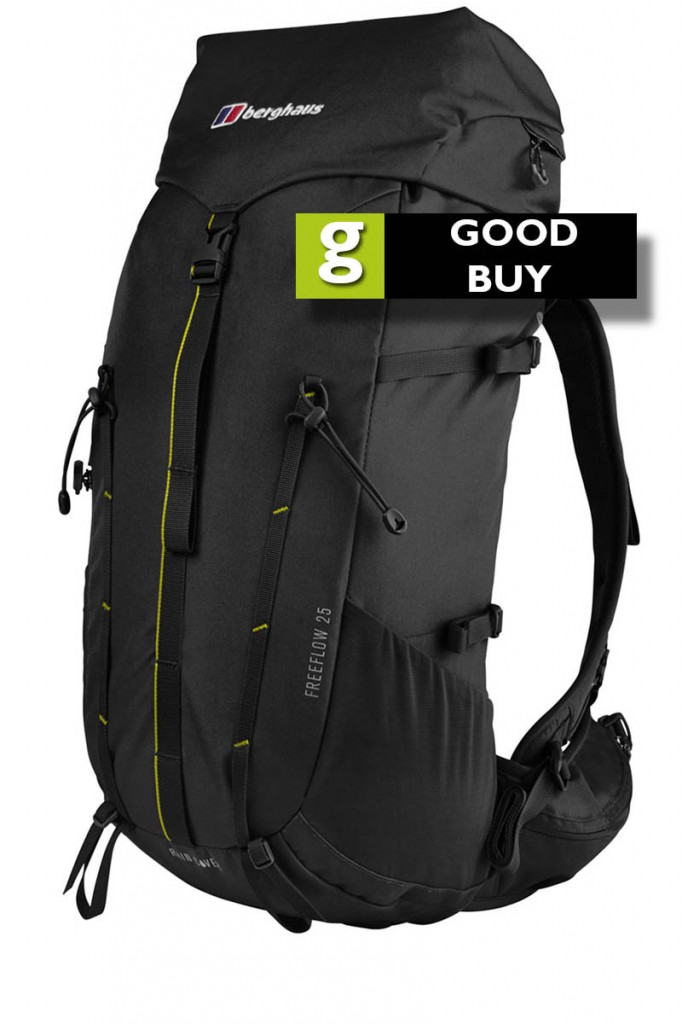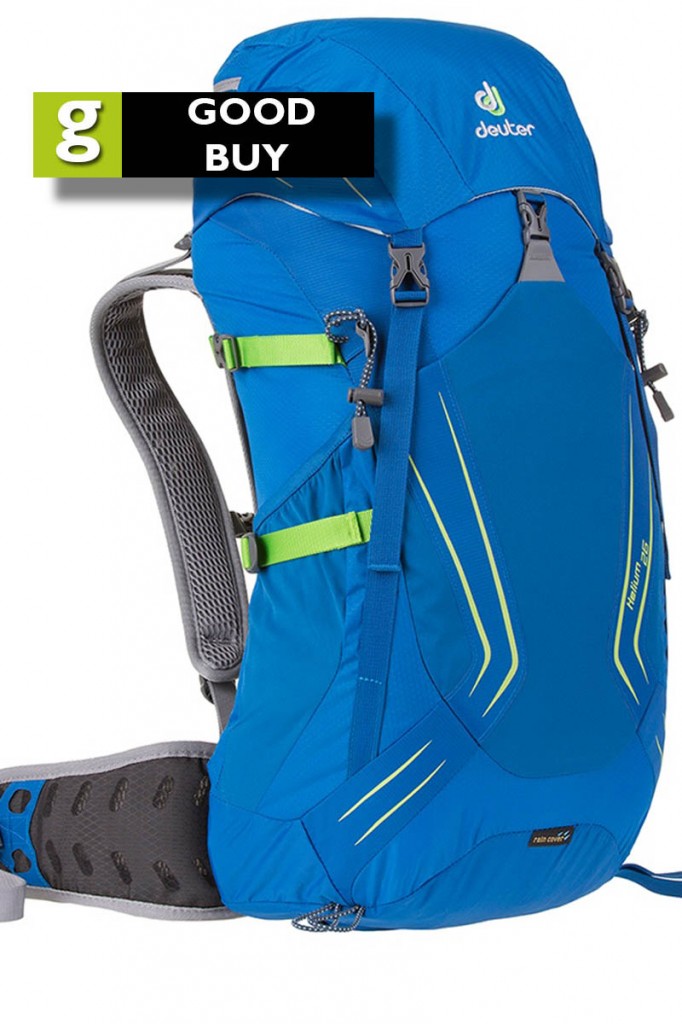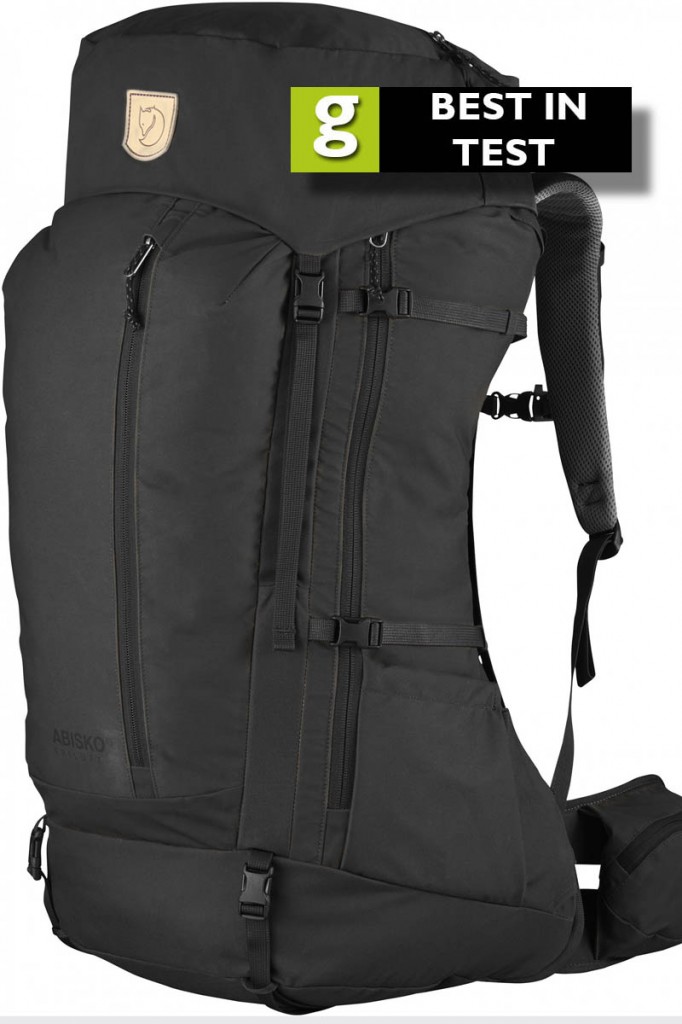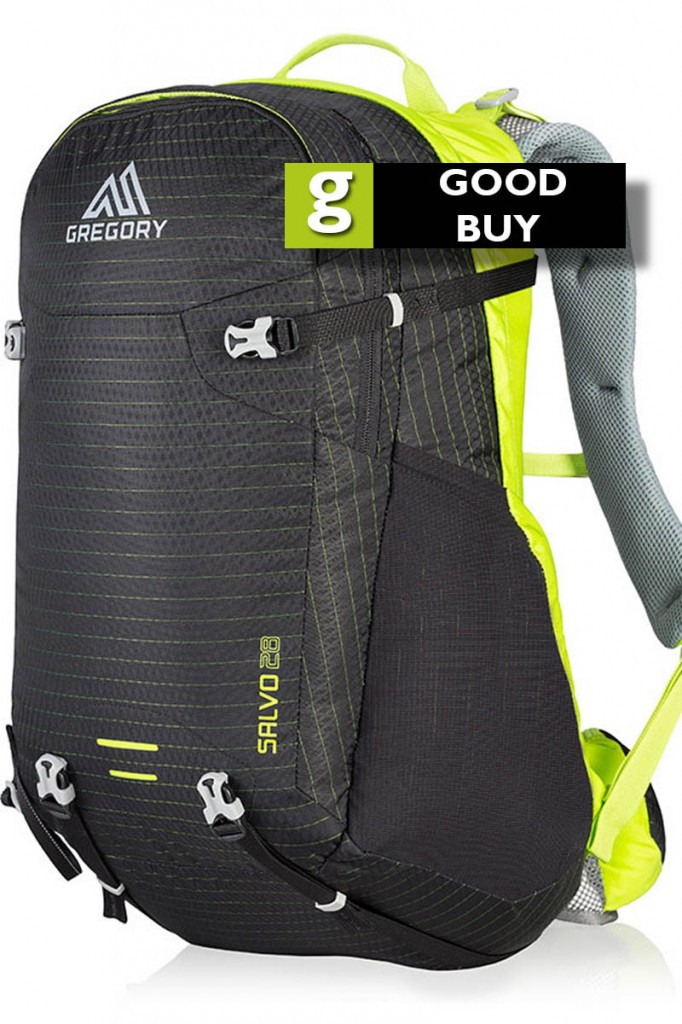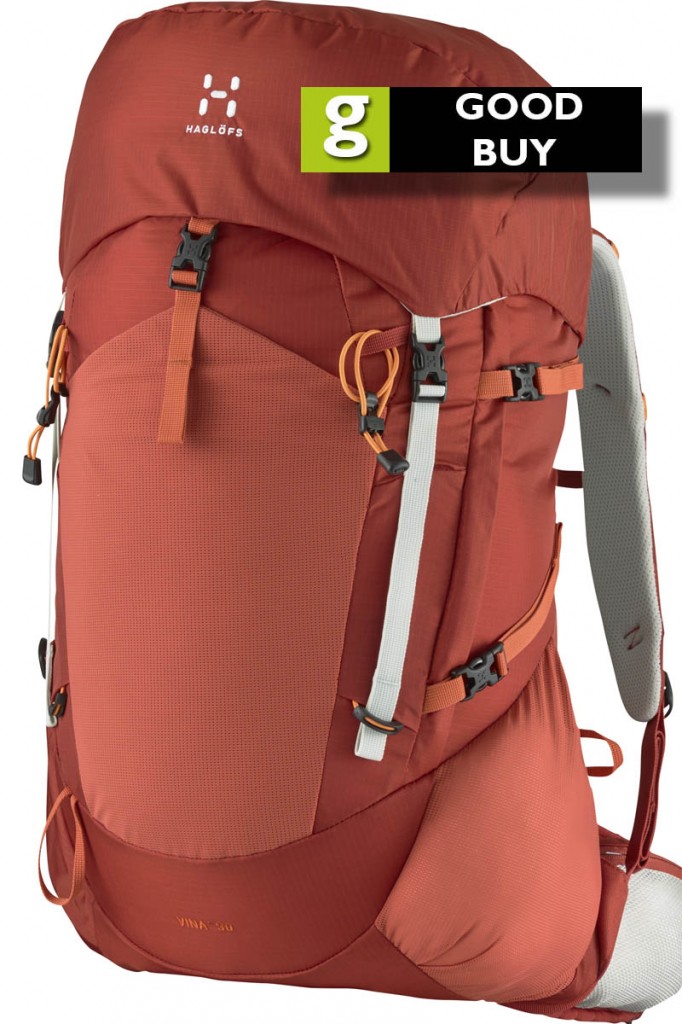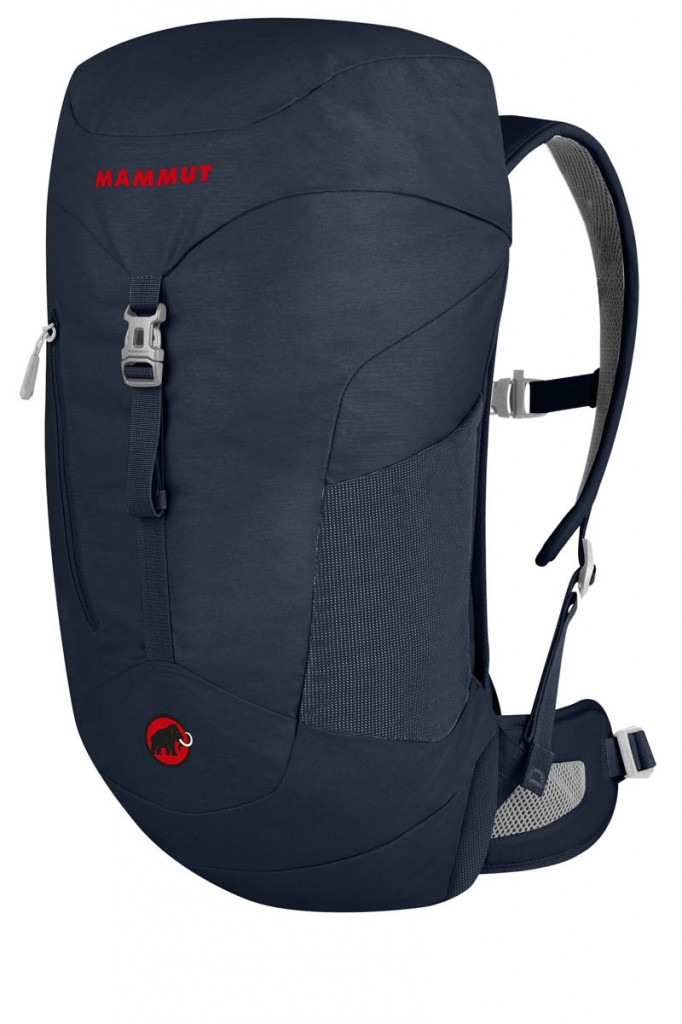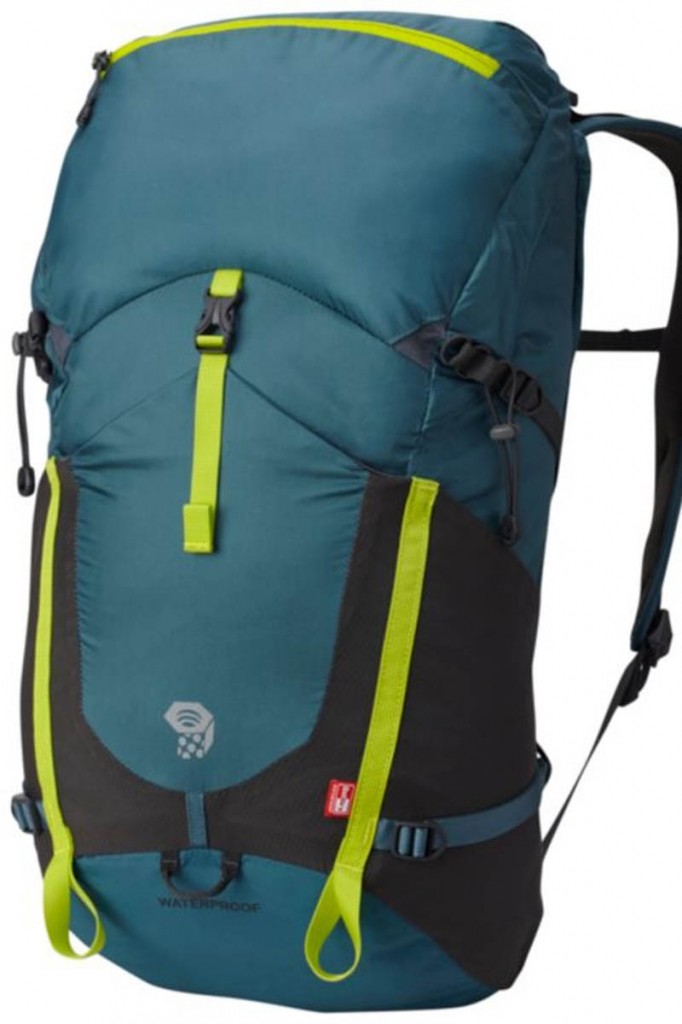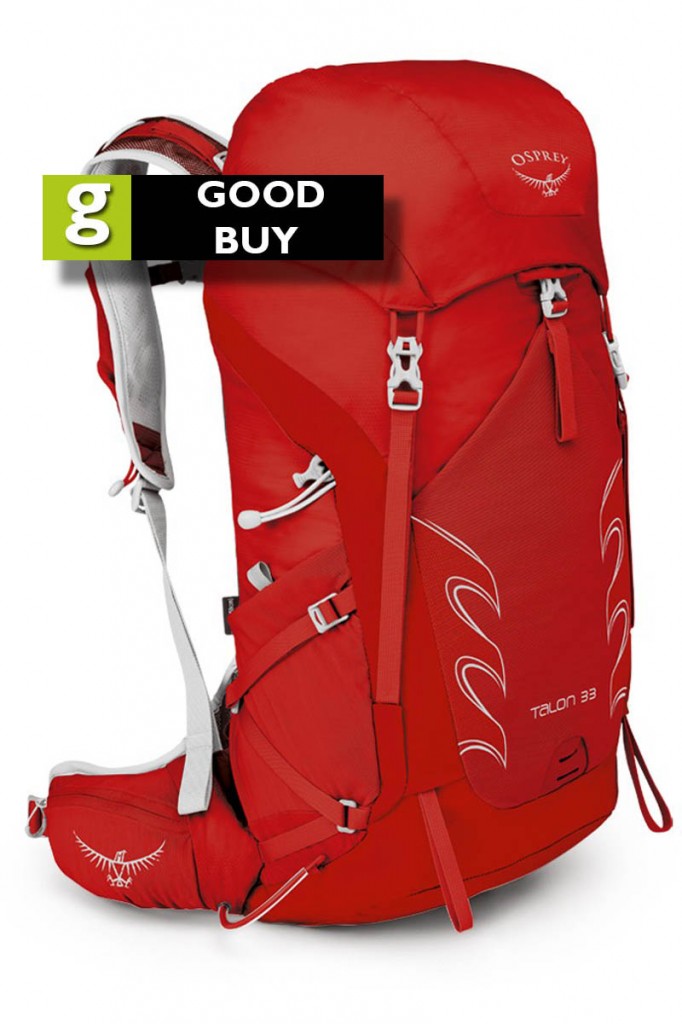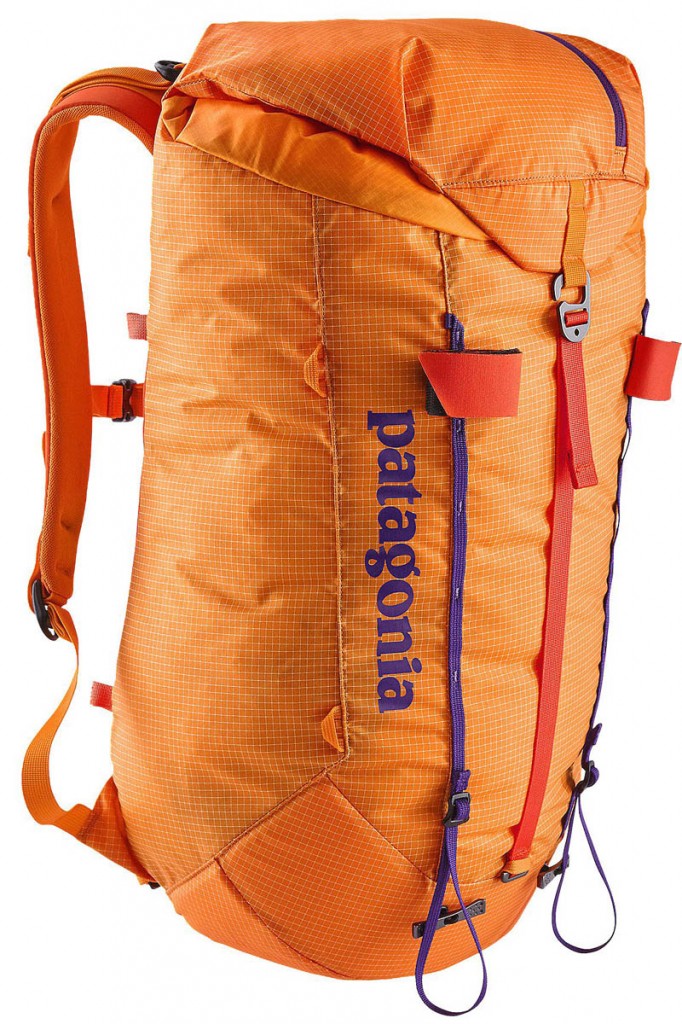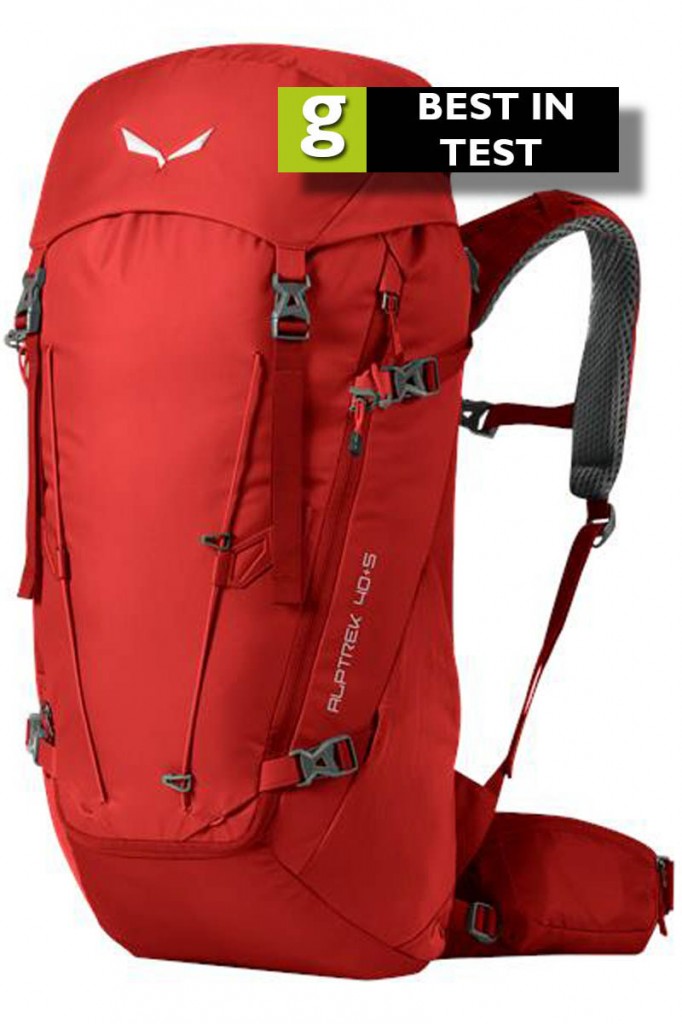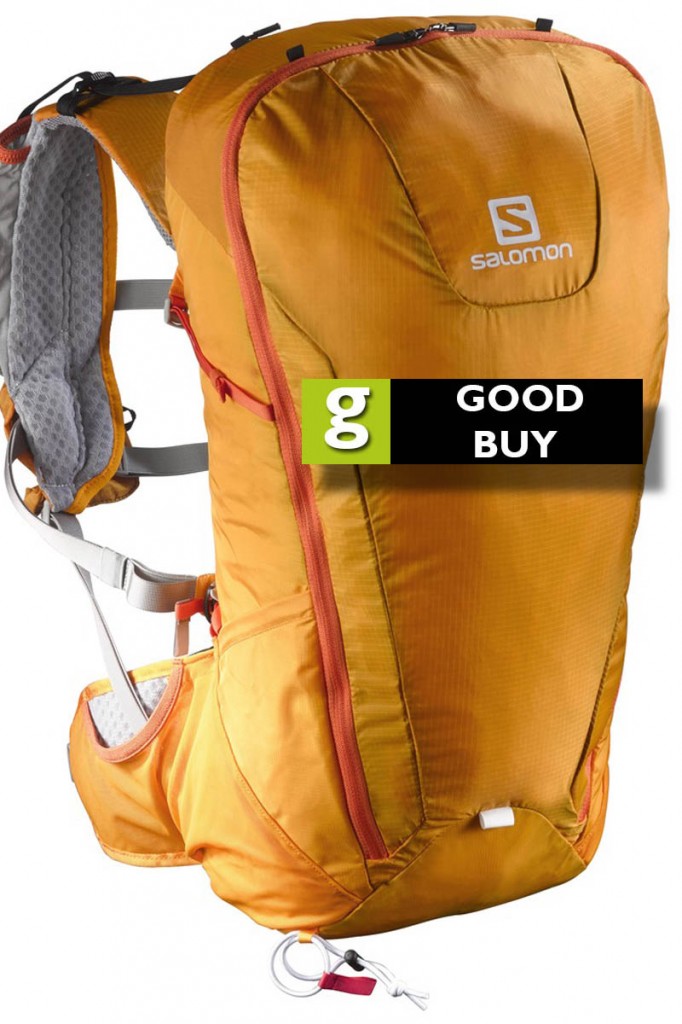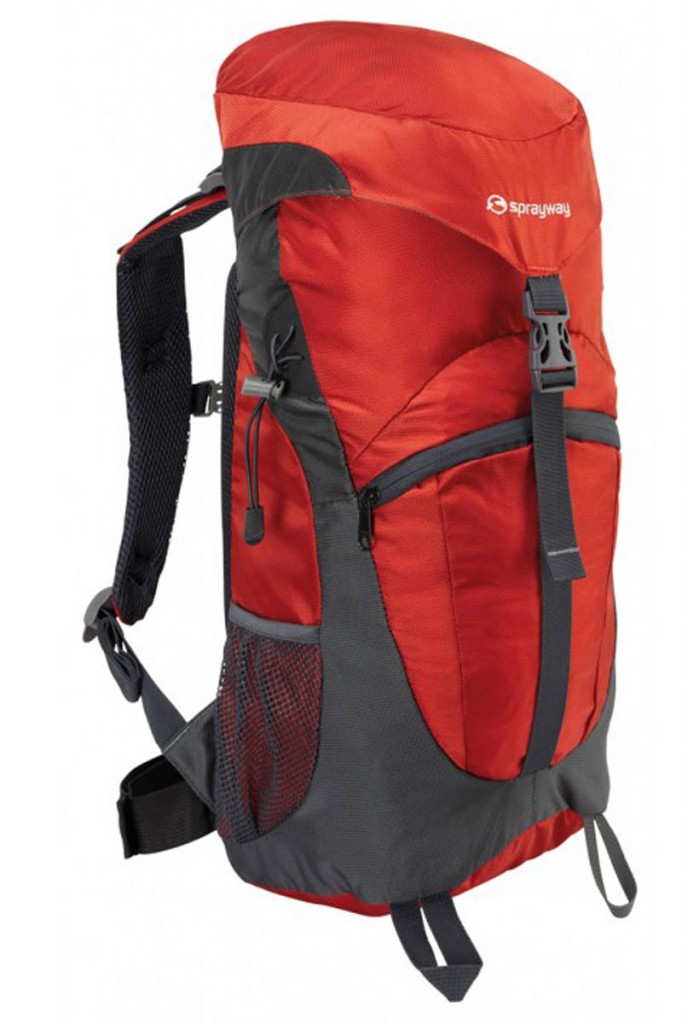A good, comfortable rucksack will enhance the enjoyment of your outdoor trips; an uncomfortable one will leave you possibly aching and desperate to take it off.
A daysack should be big enough to take all you need for your trip, support the weight of the load well and prevent strain on the neck and shoulders.
We tested the packs in our review using a ‘standard’ summer kit to carry, which included a waterproof jacket and trousers, additional midlayer, lightweight insulated jacket, hat, gloves and an emergency plastic bivvy bag.
We also loaded in our bits-and-bogs bag, which contains compass, whistle, small notebook, headtorch, pen, plus keys, wallet and spare change.
And we carried a 1.5 litre water reservoir and, of course some sandwiches and snacks.
We tested how well the packs performed: how well they supported the load; felt balanced and stable; and accommodated the contents. We also rated how comfortable they were, both in their straps, back and harness and also how well they provided ventilation for the back.
Among the 14 packs was a wide variety of designs and specialist designs, from urban commuter to multi-day hikes to fast-moving lightweight mountain events.
So as well as the overall ratings, it’s important to use our test to decide which pack works best for the uses you’re likely to put it to.
Antler Urbanite
Price: £49
Weight: 870g
Colour: blue
Rated capacity: 25 litres
Country of manufacture: China
The Antler pack differs from others in the test in that it is firmly designed with urban use in mind, rather than trips on the hill. Hence the name.
The Urbanite is made from tough-feeling nylon outer and has compartments galore.
The main one is fairly roomy and contains a removable soft laptop pouch, with a broad hook-and-loop elasticated restraining strip at the top. Within the main compartment is a further restraining strap with hook-and-loop fastening, which can be used to keep the pouch, or other contents, in place.
The main compartment has a full zip with double pullers, which opens right to the base of the pack. There are gussets which help stop contents falling out when the zip is fully opened. Within the main compartment is a further small pocket, big enough for a smartphone or similar-sized item.
This Antler pack also comes with a small combination lock that allows the main compartment or the front pocket to be secured via the twin zip pullers. A further pocket on the front of the pack can also be locked, using a small d-ring and the zip puller.
This compartment has a zipped flap opening, which gives access to a good-sized area, big enough to fit a standard laptop or document file.
A smaller zipped compartment on the front of the Urbanite again has gussets to hold in contents. Within this are a mesh pocket, a small pocket that accommodates a smartphone, plus two pen slots. There is also a further deepish zipped pocket within this compartment. This front compartment can also be locked via a d-ring.
The final compartment on the front of the pack is again zipped and has a small elasticated mesh gusset at the bottom of the zip. This is lined by tough-feeling polyester and will accommodate a small tablet computer.
The Antler pack also has twin mesh drinks bottle pockets on its flanks, which have elasticated openings,
The base of the pack has toughened nylon material.
The harness, which doesn’t have a hip or chest strap, has foam-filled mesh sections on its inner surfaces and on the shoulder areas. The back also has a good amount of mesh-covered padding, with an air channel in the centre of the back area. The pack has a top haul strap.
The Urbanite won’t accommodate a hydration reservoir.
In use, the Antler pack did take our standard hill-day gear, though stuffing the main compartment fairly full did mean the back bulged a little, reducing the effectiveness of the air channel.
It was reasonably comfortable with our standard load, with the harness providing some cushioning on the shoulders, though because there is no waist or chest strap, the full weight is borne by the two shoulder straps.
Used for its intended urban and commuting purposes, the Antler pack performed well, swallowing up lots of gear and keeping our laptop and other electronic equipment safe, leaving enough room for waterproofs and the other essentials for city life.
The materials feel very robust and the inclusion of a lock lends peace of mind for security of the contents in crowded situations.
Performance 26/35
Comfort 24/35
Features 9/10
Quality 7/10
Value for money 8/10
Total score: 74/100
Aquapac Wet & Dry Backpack 35l
Price: £80
Weight: 820g
Colour: black
Rated capacity: 35 litres
Country of manufacture: China
Few rucksacks are truly waterproof; rain tends to enter via untapped seams and other unguarded points of ingress. Hence the fact many include a rain cover, which effectively acts like an overall raincoat for the pack.
The Aquapac is waterproof, which means it can be used with confidence not only in heavy rain but also on a paddling trip.
The Wet & Dry 35l is the largest in the range, and essentially has one large main compartment which easily swallowed our standard hill kit with lots of room to spare.
Within the main compartment is a large, yellow-coloured separate dry bag, so you can put any wet gear in this without it soaking the rest of the pack’s contents. It zips out too, which makes putting items in easy. The inner dry pocket has a hook-and-loop strip to close it, though this doesn’t run the full width of the bag. There’s a hanging loop for drying it out after use. On the outside of this dry bag is another pouch, a transparent one, for smaller items you may want to keep dry. This has a roll-top fastening.
The main compartment of the Aquapac rucksack has a roll-top fastening. After a couple of rolls of the pack’s top, the plastic buckle is fastened and this has a couple of toggles which go into two strong loops to keep the arrangement neat.
The pack has a very large mesh pocket on each side, with an elasticated top. These are big enough to accommodate a 2l bottle.
The back is simple, with no ventilation. It has a removable flat support contained within a pouch, secured by hook-and-loop strips. This can be used as a sit-mat on the trail, or removed after use for faster drying.
Using a hydration reservoir with roll-sealing packs is a little problematic as the drinking tube exit risks compromising the waterproofing of the main compartment if placed here. We managed to squeeze our drink reservoir into the pocket containing the removable back support, which sits outside the main compartment, though anything bigger than a 1.5l bladder might be problematic. Placing the bladder in the side pockets was also possible, but that slews the weight to one side of the pack.
The Wet & Dry Backpack’s harness is ventilated but doesn’t have much padding. The straps are quite wide, but we found the weight tended to be borne mainly by the inner edges unless the sternum strap is worn very high. The chest strap is adjustable easily up and down, though adjusting its length was fiddly.
The waist strap has no padding and is detachable via plastic buckles at either side. This means securing it in use has to be done via one of these, rather than the more conventional set-up with a central buckle. It’s quite a stretch round to reach one of these while wearing the pack. We found it best to leave the shoulder straps loose and swing the pack round slightly to fasten it before adjusting all the straps.
There are plenty of carabiner loops on the harness straps, and the front of the pack also has a loop to which a rear light can also be attached for cyclists. The pack comes with a little, non-load-bearing spring carabiner for attaching a piece of gear.
In use, the capacity of the Aquapac rucksack was impressive, and seems bigger than its stated 35l. It kept out heavy rain without problem and was reasonably comfortable, though some padding in the harness straps and a wider hip section of the lower belt would improve comfort. The pack is quite deep and tends to site low on the back, meaning with a full load it has a tendency to pull back a little. We pulled the tension adjusters in fully when wearing it. There’s no back ventilation so there was a fair build-up of sweat while moving uphill.
The material feels very tough yet its pared-down design keeps the weight to a reasonable level. Watersport enthusiasts will appreciate the waterproof aspect of the rucksack: it’s rated at IPX6, which means it has withstood powerful jets directed at it, but note it’s not classed as a submersible pack.
Performance 31/35
Comfort 23/35
Features 7/10
Quality 7/10
Value for money 7/10
Total score: 75/100
Berghaus Freeflow 25
Price: £75
Weight: 1,138g
Colour: black
Rated capacity: 25 litres
Country of manufacture: Vietnam
This new model in the Berghaus Freeflow range is a neat daysack with a main compartment that was pretty much filled by our standard hill kit. It has a curved back to help provide back ventilation, though this design does intrude slightly into the main compartment.
There is also a large zipped compartment on the front of the Freeflow 25, big enough to take a laminated OS map.
The lid zipped lid will also take a little extra gear and also has a key clip. Under the lid is another small zipped compartment.
The main compartment has a conventional drawcord closure, which is then covered by the lid, secured by a single strap and buckle.
Within the main area is a pouch for a hydration reservoir, with a loop to support it. The drink tube exits via a cowled opening on the right shoulder and there’s a fabric loop on the harness strap to pass it through.
There are twin walking-pole or ice-axe attachments, with adjustable loops at the bottom and adjustable bungee straps at the top. The pack front also has 10 daisy-chain attachments.
There are twin stretchy mesh pockets at the sides of the rucksack, and a rain cover sits in its base in a compartment secured by a hook-and-loop strip. There are twin compression straps either side of the pack.
The pack’s harness straps are ventilated, with about the right amount of padding for a small rucksack, without adding unnecessarily to the weight. The sternum strap can be placed in one of four positions, adjustable via a fiddly system that involves removing each side and sliding it back into place. It has an elasticated section for added comfort.
The hip belt is broad and also ventilated, with some padding. There is a small zipped pocket on the right, handy for small items needed on the trail, and the left hip belt has three daisy-chain webbing attachment points.
The Airflow back is one of the pack’s main features. It has a rigid, curved back plate that sits clear of the back. The pack is then supported by two longitudinal webbing straps kept under tension by internal attachment within the pack. A soft, ventilated mesh strap then crosses these laterally about mid-back level, and there are ventilated, well-padded lateral sections at the top and base of the back.
In practice, these worked well, and supported the pack well on the back while maintaining a good airflow. The only places there was any appreciable sweat build-up was where the padded areas crossed the back. The system also kept the rucksack in a comfortable position high on the back, and didn’t slip down.
The Berghaus pack was comfortable and its material feels tough, which is confirmed by the relatively high weight for a small rucksack. It was just about the right size for hill trips outside of the winter months when you’re not packing all the extras necessary then. The design is neat, with a narrow body that sat well in position and wasn’t too deep, keeping the weight fairly close to the back, despite the curved nature of the Freeflow system.
Performance 31/35
Comfort 30/35
Features 7/10
Quality 7/10
Value for money 7/10
Total score: 82/100
Deuter Helium 26
Price: £90
Weight: 1,190g
Colour: blue
Rated capacity: 26 litres
Country of manufacture: Vietnam
The Deuter pack is another that has a curved back system to keep an airflow in that area.
The Helium 26 uses two crossed metal struts as its frame, combined with two flat metal stays at the side of the back, with hip fins which help spread the load. This gives the pack a good stability. The Aircomfort Flexlite system has a springy mesh panel to which the top of the harness straps are attached.
Air can enter from each side of this panel, as well as from the lower section.
The main compartment swallowed our standard kit with a little space to spare, despite the curved back intruding slightly. Within the compartment is a pouch for a hydration bladder, along with a hook-and-loop suspension strap. Drinking tube exit is via the right shoulder, and there’s an elasticated strip on the harness that the tube can be passed through.
Closure is via a drawcord through its top gaiter. There’s also a webbing tension belt with a buckle to pull the opening together. This could also be used for securing a rope under. The whole thing is covered by the lid, which is fastened by two webbing straps and buckles. The lid has a smallish zipped pocket which contains a key clip.
Under the lid is a printed panel with instructions for calling help in an emergency, including whistle and light signals, along with arm signs to aircraft.
The body of the pack in constructed from a combination of Hexlite 100 and microrip fabric, designed to offer both toughness and light weights.
There’s stretch front pocket with a buckle and webbing fastening, for wet clothing to be placed in.
The Deuter pack has two deep stretch pockets on its side for drink bottles. They’ll also fit a laminated OS map.
There are twin compression straps each side and a fabric ice-axe loop with bungee attachment at the top. The Helium 26 also has twin shockcord walking pole loops with bungee retainers at the top of the body. A rain cover sits in a zipped compartment at the base of the pack.
The harness straps are ventilated and padded, and the hipbelt is broad, ventilated and padded. The whole thing, combined with the frame struts and fins, give a good stable feel to load carrying. The hipbelt and back have twin lumbar padded sections which help support the pack’s weight well.
The hipbelt is easily adjustable via ‘pull-forward’ straps. There’s a small zipped pocket on the right side. The sternum strap is easily adjustable via ‘rails’ and has an elasticated section.
The back system works well at ventilating, with only the very top and lumbar pads having a build-up of sweat, all other parts of the back being clear of the pack.
The Deuter Helium 26 is a well-designed, comfortable pack and manufacturing quality was good. We’d be happy using the rucksack on anything from a country stroll to a mountain day trip.
Performance 30/35
Comfort 31/35
Features 7/10
Quality 8/10
Value for money 7/10
Total score: 83/100
Fjällräven Abisko Friluft
Price: £150
Weight: 1,616g
Colour: grey
Rated capacity: 35 litres
Country of manufacture: Vietnam
The Abisko Friluft also has a curved back to help ventilation. It has a big main compartment that easily accommodated our standard hill kit with plenty of room to spare.
But should you need more space, the Fjällräven rucksack has a large gaiter at its top opening, along with a floating lid that allows you to overstuff the pack if necessary. The gaiter has a drawcord closure and there is also a webbing and plastic buckle tensioner to cinch the pack’s top in nice and snug. Incorporated into this is a rear metal hook that gives another point of retention to keep the lid in position, particularly if using it in a floating mode.
The tensioner can also be used to retain a rope between the main compartment and lid. The pack’s lid is fastened by two webbing and buckle straps.
The lid itself has a fairly large zipped pocket, in which the untethered rain cover is stashed in its own little hook-and-loop fastening bag. There’s also a zipped compartment in the underside of the lid. The lid also has two small webbing loops for attaching items such as a helmet.
As well as the top opening, the main compartment can be accessed via zipped openings that run almost the full length of each side of the pack’s front panel. This is handy for getting to those things at the bottom of the rucksack that you imagined you wouldn’t need so soon. Let’s be honest, we’ve all been there. The other advantage of this is you can lay the pack on its back and unzip both to peel back the front panel, revealing pretty much the whole of the main compartment’s contents.
We found this particularly handy in a small tent where it’s not that easy to stand a rucksack upright. The top of the front panel is held in place when closed by a broad hook-and-loop strip.
Within the main compartment is a pouch for hydration bladder, with an exit for the drink tube on the right shoulder.
On the front of the pack is a large, zipped pocket, useful for maps or wet clothing you want to keep separate. There are twin compression straps either side of the rucksack.
There are gusseted drinks bottle pockets on each side of the pack, each of which has a shockcord with spring toggle for cinching in the top of the pocket.
The back has a one-piece aluminium frame running down either side and bottom of the pack, with a rigid plate on the inside of the pack about mid back level. There’s a stretchy mesh panel that sits against the user’s back, with a large area then between this and the back of the pack to enable air circulation. Another stretch mesh panel sits against the back at lower level, and this connects to the hip belt, which has large cut out areas to improve ventilation and reduce weight.
The hip belt is broad with ventilation and padding, and a broad webbing centre section with beefy plastic buckles. There are small zipped pockets on each side of the hip belt.
The harness straps are wide with some ventilated padding, and each has a narrow webbing strap part way down to help retain a drinking tube or to take a carabiner. The sternum strap is adjustable for height along rails and has an elasticated section for comfort. The buckle incorporates a whistle.
There’s an upper bungee loop for holding ice axe or walking poles. We stuffed the bottom of the poles into the left outer pocket and cinched it in to hold them firmly.
There are two adjustable straps at the bottom of the pack, useful for holding additional gear such as a tent.
The material feels tough. Most of the pack is made from G-1000 Eco, a mix of recycled polyester and organic cotton, so the Abisko Friluft 35’s green credentials are strong. The base is a tough nylon.
In use, we found the Fjällräven comfortable and well balanced. The harness straps have just about the right amount of padding and the hip belt held the pack well. Ventilation at the back was quite good too.
The Abisko Friluft 35 has lots of little features that give you the impression it has been designed by someone who understands the needs of the user. Quality is very good and the rucksack has a very solid feel, reflected in the fact it’s the heaviest in the test. The quality doesn’t come cheap either, as it tops the price list.
But the Fjällräven Abisko Friluft 35’s should give many years’ service and is a good load carrier and comfortable on the hill. It’s also large enough to consider for use as a winter day sack.
Performance 32/35
Comfort 30/35
Features 8/10
Quality 8/10
Value for money 6/10
Total score: 84/100
Gregory Salvo 28
Price: £75
Weight: 1,116g
Colour: black/green
Rated capacity: 28 litres
Country of manufacture: not stated
The Salvo 28 is a compact pack with multiple pockets, adding up to a total of 28 litres space.
It has a deceptively technical core, with FreeSpan ventilated suspension giving the rucksack its load-bearing stability and allowing back ventilation. There’s a lumbar pad which connects to a steel frame that encompasses the perimeter of the back. Along with this, a broad rigid plate runs laterally across the central area of the pack’s back.
This gives the little Gregory pack the ability to support more weight than you would expect. Its stated maximum load is 11.3kg. A mesh panel holds the pack away from the user’s back to provide ventilation, and the lumbar pad is also well ventilated, with deep cutouts.
The main compartment of the Salvo 28 has a zip top and no lid. It doesn’t look that big but swallowed all of our standard summer hill kit. Within the compartment is a hydration bladder pouch with suspension loop. The drinking tube exit is central on top of the pack.
On the front of the pack is a second, zipped compartment, big enough to contain wet clothing. This contains another small, zipped mesh pocket for oddments, which has a key clip.
The front of the Gregory pack has another smaller, zipped pocket. There are a couple of compression straps on the rucksack and it has two stretch mesh side pockets for drinks bottles.
There are also bottom straps for attaching gear, and the pack also has an attachment point for a rear cycle lamp. The Salvo 28 has a lower adjustable loop for ice-axe or walking poles, with an upper bungee strap to retain these.
The harness straps are ventilated with cut-out sections and mesh, and the foam is comfortable. The right strap has a useful plastic clip attached to the chest strap mount for retaining a drinking tube and there’s a loop on the left harness for holding sunglasses. The sternum strap adjusts for height on rails.
The hip belt is wide with a reasonable amount of padding and is also ventilated. There are small zipped pockets on each side and the belt buckles adjust by pulling forward.
The Salvo 28 sits comfortably on the back and supports its load well. The pack felt stable in use and the lumbar support bore a good deal of the weight. The ventilated back provided some air to the user’s back, particularly at the top, but things got a little clammier on the lower back.
The design and quality of the Gregory pack were good, with solid-feeling fabric and fittings. It is well thought out and has plenty of room for a typical day walk outside of the winter months. Comfort on longer walks was good too.
Performance 30/35
Comfort 30/35
Features 7/10
Quality 8/10
Value for money 7/10
Total score: 82/100
Haglöfs Vina 30
Price: £110
Weight: 1,134g
Colour: red
Rated capacity: 30 litres
Country of manufacture: Vietnam
The Vina 30 is a top-loading pack that also has a ventilating back.
Access to the main compartment is via the drawcord-adjusting opening at the top of the rucksack, which has a generous gaiter. There’s also a webbing strap with buckle closure, which could be used for securing a rope across the top of the opening.
A lid then covers the opening. This has a good-sized zipped pocket with key clip. The lid rim is also partly elasticated to help keep it snug over the opening.
The main body of the Haglöfs pack has twin compression straps on each side. When fully extended, these give plenty of room in the main compartment, which easily swallowed our standard kit with space to spare. There’s a hydration reservoir pocket within the main compartment, with a webbing strap with plastic hook to suspend it. Drinking tube exit is via a slot on the left shoulder.
The main compartment can also be accessed by a side zip, with double pullers. This makes it easy to get to items at the bottom or part-way down the pack without taking out all the contents. The zip is secured at the top by a sturdy press-stud fastener.
On the front of the pack is a large stretch mesh pocket which is good for stuffing wet clothing in to keep separate from other items. On the lower left front is a smallish zipped pocket and on the opposite side is a stretch pocket for a drink bottle. This is nicely designed so that the bottle goes in at an angle from the front rather than the top, and the pocket has a webbing loop on its top edge. This makes getting a bottle in and out much easier than a conventional set-up without taking the pack off. The bottle sits diagonally in the pocket to stop it falling out.
The Vina 30 has a lower ice-axe loop with a bungee fastening at the top of the pack to secure it. This doubles as one of two walking pole attachment points. The twin lower bungees have plastic pullers to aid use, and the top ones secure easily and also have a small webbing strap to undo them.
The Haglöfs rucksack has a metal cross frame, which also goes over the top and bottom of the pack. It is curved to allow the Airback, a stretch mesh panel, to provide space between the rucksack and the user’s back. The frame supports the load well, and the 210 denier polyamide and 600 denier polyester in the lumbar area keep the pack in shape even when carrying a good weight.
The hipbelt is broad and ventilated with some padding, and there is a zipped mesh pocket on each side.
The harness shoulder straps are similarly ventilated. The foam is fairly firm but there was no discomfort from this. There are elastic drink tube routers on each strap. The sternum strap adjusts for height via rails on each harness strap.
The Vina 30 provided good comfort and was roomy for its stated capacity. The curved back intruded slightly into the main compartment, but there was still plenty of space. The Airback worked reasonably well, though there was some build-up of moisture, particularly in the lower back.
The Haglöfs pack supported the load well and was good quality. There are nice design touches and the side zip is very useful for reaching items without unfastening the top and lid. The Vina 30 is also available in two sizes.
Performance 31/35
Comfort 30/35
Features 8/10
Quality 7/10
Value for money 7/10
Total score: 83/100
Mammut Creon Tour
Price: £75
Weight: 960g
Colour: dark blue
Rated capacity: 28 litres
Country of manufacture: Vietnam
The Creon Tour is a compact, fairly minimalist pack that tips the scales at about a kilogram.
The rucksack is made from 420 denier ripstop nylon with an unusual matte face that Mammut says offers excellent abrasion resistance.
The main compartment is accessed via a top opening with drawcord fastening and a gaiter in tough-feeling fabric. Inside, there is no pouch for hydration reservoir, just a suspension strap with hook-and-loop fastening. Drinking tube exit is via the right shoulder.
The opening is covered by a lid with single buckle fastening. The lid has a reasonably large zipped pocket.
On the front of the pack is a medium sized zipped pocket, big enough to accommodate a laminated OS map.
The pack’s body is narrower at the bottom and wider at the top. There are no compression straps.
It has twin stretch mesh pockets at the sides for drink bottles. There is an ice-axe loop and a second loop for walking poles. A top bungee is used for securing both.
The Contact Stream back has a curved main plate which combines with a lumbar cross member and metal frame across the top and sides to give good stability with loads. The mesh back support has ventilated plastic section and this set-up keeps the pack well away from the back and provides very efficient airflow, with very little moisture build-up. There is a padded, ventilated section at the shoulders and similar twin sections at the lumbar area. There was a little more dampness at these areas, but in general the Contact Stream system worked well without feeling that the load was too far away from the body.
The harness straps have foam padding with a little ventilation. The right strap has an elasticated guide loop for a hydration tube. The sternum strap is part elasticated and is repositionable in four height settings through a daisy-chain arrangement, which is fussier and less convenient than a constant rail setup. The buckle has a built-in whistle.
The hip belt is padded and has a good amount of ventilation. Length adjustment is through a pull-forward arrangement.
The pack has a built-in rain cover in its base, with a strong hook-and-loop closure.
The Mammut Creon Tour is neat and compact, but the main compartment is not that big. Its pared-down design allows a weight to be kept down and the back ventilation system works well. It was comfortable on the hill, but the lack of an internal pouch for a hydration bladder means careful positioning of the main compartment’s contents is necessary to avoid the possibility of disrupting the flow of water through a drink tube.
Performance 29/35
Comfort 30/35
Features 6/10
Quality 7/10
Value for money 7/10
Total score: 79/100
Mountain Hardwear Rainshadow 26 Outdry
Price: £90
Weight: 708g
Colour: blue-green
Rated capacity: 27 litres
Country of manufacture: Philippines
The Rainshadow pack is one of the few in the test that is properly waterproof, thanks to its OutDry membrane and taped seams in the main compartment.
The rucksack is accessed via a zipped top – there is no lid. The zip has external and internal storm flaps to keep the rain out.
The main compartment is fairly compact. It took our standard summer kit with just a little space to spare. At the top of the main area, within the waterproof compartment is a zipped, soft-lined pocket with key clip.
On the outside of the pack, there’s another zipped pocket, big enough to take a laminated OS map. Below this is a medium sized pocket with a plastic buckle closure, for stashing items such as wet clothing. It has a mesh lower section to allow drainage.
There are twin stretch mesh side pockets for drinks bottles, and the pack has dual compression straps on each side. There are two ice-axe loops which can also be used for walking poles, and upper bungee retainers for these.
To avoid a drink tube compromising the waterproof main compartment, the pocket for a hydration reservoir is on the back of the pack, and has a suspension loop. It’s a little fiddly getting a bladder into it, especially if the suspension adjustment straps on the harness are pulled in tight. The drink tube can exit to either shoulder and there are a couple of guide loops on each strap for the tube.
The harness itself is fairly simple, with a little ventilation but some padding, though the straps were fairly comfortable as they’re quite soft fabric.
The sternum strap is adjustable for height via webbing straps on the harness. The hip belt has no padding or ventilation and is simply a webbing strap with buckle.
The rucksack relies for its structural stiffness on a ribbed back which is only partially effective. When the main compartment is full, it bulges in a convex fashion, and offering little in the way of lateral support. The back itself consists of ventilated foam with a couple of cutaway channels and a central mesh-covered one.
Because of the lack of back stiffness and its bulge, the ribs in the pack’s back can be felt markedly when it’s worn, and there was also a noticeable build-up of moisture as the pack sits against the user’s back.
In use, it’s great to know your gear is going to emerge dry from the pack even if it’s pouring down on the hill. The Mountain Hardwear rucksack has nice clean lines and is just about big enough for a typical summer hill walk.
Disappointingly, it’s let down by its less than ideal back, the horizontal ribs of which can be felt against the user’s back, especially on warmer days when only wearing, say, a t-shirt. It also leads to a fair build-up of moisture on the back and the curvature of the pack’s back means it feels a little less stable, though being small, there’s no great sideways pull when tackling technical terrain.
The hipbelt is rudimentary too, with no padding or ventilation, meaning comfort is sacrificed if it is tightened beyond a certain point.
Performance 29/35
Comfort 22/35
Features 6/10
Quality 7/10
Value for money 6/10
Total score: 70/100
Osprey Talon 33
Price: £100
Weight: 902g
Colour: red
Rated capacity: 33 litres (M/L), 31 litres (S/M); women’s Tempest 30 version 30 litres (WS/WM), 28 litres (WXS/WS)
Country of manufacture: Vietnam
This is the latest incarnation of rucksack specialists Osprey’s Talon daysack.
The new model has nice clean lines with a spacious main compartment and the pack has lots of well-thought-out features and designs.
The back has a shallow inward curve towards the lumbar region and is Osprey’s AirScape design. This has a lightweight but sturdy feeling mesh in contact with the user’s back. Under this is a cut-out patterned foam backing, with a space between the two. This isn’t wide enough to make the load sit too far out from the back, with the resultant instability, but did provide some ventilation that kept down perspiration to a fair degree.
The back has a semi-rigid panel, which gives the pack its load-carrying stability. There’s no metal frame, which helps keep weight comfortably below 1kg, but the pack maintains its structural integrity well despite this. Unusually for a rucksack this size, the back length is adjustable via two large hook-and-loop patches between the back and the harness yolk. The harness has three pairs of markings to guide your adjustment, but it can be tricky to line up left and right evenly.
The hip belts are broad and form an extension to a soft mesh area that goes across the lumbar region, and the belts are backed in the same comfortable mesh. The hip belts terminate with a narrower webbing section with sturdy feeling plastic buckles. Adjustment is by pulling forwards. On each side of the hip belt are easily accessible zipped pouches, big enough to take items such as a smartphone, compass or GPS unit.
The main fabric of the pack is tough-feeling ripstop and is coated internally to help keep the rain out, though it can’t be classed as waterproof because the seams aren’t taped. The main compartment easily accommodated our standard summer kit.
Closure of the top-loading main compartment is by drawcord, with a second webbing compression strap and plastic buckle. The lid has a medium-sized, zipped outer pocket and under the lid is a fair-sized zipped mesh pocket that contains a key clip.
The pocket for a hydration reservoir sits outside the main compartment, between the pack’s back and main compartment, with a suspension loop with plastic clip. A drink tube can be routed to either the left or right harness strap. There are twin stretchy loops on each strap, and the left one also has a small, stretch open pouch.
The sternum strap slides up and down rails for height adjustment and the buckle incorporates a whistle.
The pack has Osprey’s Stow-on-the-Go walking pole carrying system. This consists of a plastic-coated shockcord on the bottom of the rucksack’s left side that you can slot the end of walking poles into. There is then a second, smaller plastic-covered shockcord on the left harness strap, with spring-toggle adjustment, that you can use to retain the top ends of the poles. This means you can temporarily stash a pair of poles when you get to a section of your route that demands you keep your hands free.
It’s a little fiddly to use, and the z-poles we typically use are a little short for the system. Conventional, non-folding poles fit it fine.
For stashing poles, or ice-axes, for longer periods, the Talon 33 has twin bottom loops with bungee attachment points at the top of the pack.
The rucksack has compression straps on each side, in a zig-zag arrangement which is anchored to the hipbelt at the bottom. These can be rerouted to go into the two pack’s two stretch side pockets to provide compression without wrapping round the pockets’ contents.
The front of the Osprey pack has a large stretch mesh pocket for stashing wet clothes and the like. It also has a lamp attachment point.
An optional rain cover can be bought for the pack.
The Talon 33 has lots of nice design touches and it bore the weight well, with good comfort. Back ventilation was fairly good, though the pack does sit quite close to the user. Quality was good and weight was also good for a pack of this capacity.
Performance 31/35
Comfort 30/35
Features 8/10
Quality 7/10
Value for money 7/10
Total score: 83/100
Patagonia Ascensionist 30
Price: £130
Weight: 736g
Colour: orange
Rated capacity: 30 litres
Country of manufacture: Philippines
The Ascensionist 30 comes with a climbing pedigree. It’s minimalist and sleek, with few external fittings that are likely to catch on things while making your ascents.
The fabric is a tough-feeling 210 denier Cordura 86 per cent nylon, 14 per cent polyester mix that comes with a polyurethane coating to aid water resistance.
It is available in S and L sizes.
The main compartment is a simple, capacious area. There is a drinking tube exit in the centre of the pack, but no reservoir pouch or hanger. It is possible to undo the large hook-and-loop strip that conceals the foam back of the pack and stuff the bladder in there. Or you may be able to fashion a set-up with a small carabiner to hang the reservoir from the daisy chain in the lid.
The only other addition to the main compartment is a small zipped pocket at the top for items such as a phone and keys.
The lid is an interesting design that also incorporates the drawcord for the main opening, using a plastic cammed buckle that gives a rapid result from the rear of the top of the pack. The lid then folds forward and is fastened via a single webbing strap and flat metal hook. This can be repositioned to the top of the rucksack to enable an overstuffed pack to be secured more easily if required.
Opening the top closure is quick and easy using the cord to unlock the cam and pulling the front webbing loop. Under the lid, as mentioned, are four webbing daisy chains.
The outside of the lid has a medium-sized pocket, with the zip running at an angle close to the right side. There’s a key clip inside.
There are no other external pockets, but the Ascensionist has two conventional ice-axe or walking pole loops with buckles for adjusting their length. There are then two wide hook-and-loop attachment points at the top of the pack. An alternative attachment for ice tools is available via twin metal t-bars on shockcords which can be passed through a hole in the ice-axe head for the lower attachment.
There are twin daisy-chain strips running down the pack’s front and it also has four attachment loops for extra gear.
The harness straps have only limited padding but are quite a good width. The sternum strap’s height can be adjusted via another daisy chain array, but there are no other adornments on the straps. The hip belt is a simple webbing strap.
The body of the pack is quite stiff material which stops it flopping around when packed. There is also foam filling at the base of the rucksack. There are no compression straps.
There is no frame to the pack as such; its integrity is down to a foam panel, which is removable to save weight, in the rucksack’s back.
When packed with gear, this bows outwards. Because of this, most of the pack’s weight is borne in the mid back area of the user, rather than the more comfortable lumbar and hip area. Cinching in the harness straps tight helps redistribute the weight a little more evenly but that then means quite a bit of the burden is felt through the straps, which don’t have a lot of padding.
There’s no ventilation in the back or harness, so there was a noticeable build-up of perspiration in the back and shoulders.
The Patagonia pack is designed with climbers in mind, and its shape leaves good clearance for reaching for holds. The minimalist design keeps clutter to a minimum and the fabric is tough but lightweight and sheds a shower.
It has lots of attachment points for gear and innovative design touches.
But for any length of walk-in or for use while hiking, comfort afforded by the back and hipbelt are only moderate and there’s no ventilation which means things get clammy when working hard uphill.
Performance 30/35
Comfort 24/35
Features 6/10
Quality 8/10
Value for money 6/10
Total score: 74/100
Salewa Alptrek 40+5
Price: £125
Weight: 1,628g
Colour: red
Rated capacity: 40 litres
Country of manufacture: Vietnam
The Salewa rucksack is the biggest, and heaviest, in the test, with a 40l capacity that can be expanded by using the floating lid.
The body of the rucksack is robust 420 denier nylon and the Alptrek 40+5 has two broad metal stays attached to a rigid panel, which together form the back’s frame. This kept the Salewa pack stable on technical ground.
The back length is adjustable using the Custom-Fit Pro system. Two large ventilated foam-filled back pads are attached to the pack via big hook-and-loop strips for most of their length. Unhooking these at the bottom and lifting the pads enables them to be slid up or down before re-attaching by pressing them down. There are markings for short, medium and large settings, each with intermediate settings. The system is easy to use and enables the correct fit for different sized users.
The main compartment is large, and there was plenty of room left after it swallowed our standard summer kit. There’s a pouch for a hydration reservoir, which is tethered at the bottom corners by toggles, and which has a hook-and-loop suspension strip. Drink tube exit is to the left shoulder.
Entry into the main area is from a top opening which has a drawcord and spring toggle closure. There is then a large gaiter again with a drawcord closure, so if extra capacity is needed, the pack can be overstuffed and the floating lid used to cover the gaiter. A buckled compression strap, which can also be used to secure a rope, runs over the top opening.
The main compartment can also be accessed via a large zip opening with double pullers running down the length of the right side of the pack and across its front. This is useful for digging out items towards the bottom of the rucksack.
There are twin compression straps on each side of the Alptrek pack, and there’s also a large zipped external pocket on the front of the rucksack. The pack front has a criss-cross bungee for attaching extra gear such as crampons. The Salewa pack also has two stretch mesh pockets for drink bottles.
A bungee fastening on each side of the pack’s front is used to secure either ice-axe or walking poles, with the bottom of these either tucked into the lower compression strap or the front bungee.
As mentioned, the lid can be raised via floating straps to accommodate extra load. Under the lid is a zipped compartment and on the outside a large zipped pocket. There are also emergency signal instructions under the lid.
The harness straps are broad, with ventilated foam padding. They lead on to the two main back pads which are made from the same material. Load suspension straps at the top help pull the pack closer into the back for stability and comfort. The sternum strap slides on webbing straps for height adjustment, though this is a little fiddly.
The hipbelt is broad and has similar ventilated foam sections that run into the lumbar region of the back. There are large cutaway sections to aid ventilation further. The central part of the hipbelt is a wide webbing strap. The adjustment is via pull-forward buckles. The hip sections of the belt have a zipped pocket on each side for small items.
Ventilation for the back is via a central channel between the two main foam pads. This doesn’t afford as much air movement as some of the packs where there is a mesh suspension system, and there was some build-up of perspiration.
Quality of the Salewa pack was good and it has lots of storage space. It bears its load well and feels stable in use while being comfortable on long treks. There’s enough room for winter hill excursions too, or lightweight camping trips and the pack has lots of nice design touches.
The back was comfortable but not the best for ventilation. It is on the heavy side, but not unreasonably so for a large pack made from robust fabric.
Performance 31/35
Comfort 30/35
Features 8/10
Quality 8/10
Value for money 7/10
Total score: 84/100
Salomon Peak 30
Price: £85
Weight: 618g
Colour: orange
Rated capacity: 30 litres
Country of manufacture: Vietnam
The Salomon pack is a very different beast from the conventional rucksacks. Lightweight, pared-down, it’s aimed at walkers but has an eye on users who run too.
The Peak 30 fits into Salomon’s ‘vest’ range, the smaller models in which are firmly designed with ultrarunners and mountain marathoners in mind.
Though it’s pared down, it’s not minimalist, with lots of features to keep you going with the minimum of stops.
The main compartment is 30 litres, and is accessed via a long zip that goes from near the base of the pack, round the top and back down again, so contents are easily accessible. The same zip allows access to a second compartment on the front of the pack which is useful for stashing wet clothing or other non-bulky items.
Although lightweight, the fabric of the pack is robust-feeling ripstop nylon. The Salomon pack has twin compression straps, the top ones being conventional, but slender webbing with lightweight buckles. The bottom ones are attached to the side pockets and use spring-fastening sliders to adjust length.
There’s a hydration reservoir sleeve in the back, outside the main compartment, with another spring clip to suspend it, which is fiddly to use. Drink hose can exit to either the right or left harness strap.
A small zipped compartment sits at the top of the pack’s back, and is big enough for odd items that you want to keep separate from the main compartment.
There’s little stiffness in the back. The Airvent Agility+ panel has a large central cut-out to keep weight down and it sits in a zipped pouch so you can remove it if you want to save even more weight.
Despite the lack of firmness, the pack didn’t bow out into the user’s back when loaded and felt quite comfortable, hugging the back well and not rolling side to side. The back uses ventilated mesh material and has added padding at two side lumbar areas and at the shoulders, continuing over into the top of the harness straps.
Although the mesh is well vented, there was a fair build-up of perspiration on uphill sections as the back is in contact with the user rather than sitting away from the body.
Helping to keep the pack in place, there’s a hip belt that is also padded and ventilated, with the centre section a webbing strap. Each has a stretch pocket that’s big enough to slot in a drink bottle. As this goes is accessed horizontally, it’s easy to reach on the go without taking the pack off. These pockets are also handy for energy bars, gloves, or other small bits of gear needed on the hoof.
Behind these pockets on each side sits another pocket that will accommodate a drinks bottle, though this is harder to access on the move.
The harness straps are soft foam with ventilation, and are quite wide, which helps make for a comfortable carry. On each is a small zipped pocket, just big enough for our smartphone. The right-hand pocket has an extra small stretch mesh pocket.
Above these on the harness, at shoulder level, are two stretch mesh drinks bottle pockets. They’re slender so won’t take a standard bottle, but will take a soft bottle or very narrow one.
The load suspension adjusters use narrow webbing again secured by spring sliders. In most use these held well but are easy to pull through inadvertently when the pack’s off the back. There’s a little whistle attached by a short cord to the left harness strap.
In keeping with the running pedigree, the Peak 30 has two elastic chest straps to keep the whole thing in place in conjunction with the hipbelt. Rather than a conventional buckle, these two straps have flat plastic hooks that go round plastic loops on the opposite strap. Make sure you get them in place properly or they have a nasty habit of twanging out towards the face. The chest straps can be placed at different heights by simply unknotting them from their loops and repositioning.
The Salomon pack has the brand’s 4D Pole Holder system, which is a bit odd. On the right harness strap is an elastic loop with spring slider adjuster. You place the top of your poles into this, then pass them behind your back and reach round to secure the bottom of them into a bungee loop at the bottom left of the rucksack which has a spring toggle adjuster. The system won’t work with z-poles or any others that fold up into short sections as the top and bottom loops are too far apart for these.
There’s no ice-axe loop as such but we managed to attach one using the bottom pole bungee and securing it in the top compression strap, though if our axe was much longer than the one we used, you might struggle.
There are a couple of attachment loops at the bottom of the pack and two small ones at the top if you want to add some extra shock cord for attaching other items.
We were surprised how comfortable the Peak 30 felt in use, given that it has a very soft back panel that doesn’t give the pack much stiffness. But it hugged the back without the rucksack’s contents digging into the user, and the harness straps and hipbelt were broad enough and soft enough to support without discomfort.
The pack stayed in place very well which, if you’re doing any running, is vital. Its main compartment was big enough for our standard summer gear with a bit to spare, and the numerous harness and hipbelt pockets were very useful for accessing items and drinks without stopping.
Although it’s marketed as a hiking and backpacking rucksack, the Salomon Peak 30 is light and stable enough to be considered for ultrarunners who need to take a bit more gear for an extended trip.
Performance 29/35
Comfort 29/35
Features 8/10
Quality 7/10
Value for money 7/10
Total score: 80/100
Sprayway Sirius 35
Price: £35
Weight: 600g
Colour: red
Rated capacity: 35 litres
Country of manufacture: China
The Sirius 35 is a basic hiking rucksack at a very competitive price.
The main compartment is accessed via a top opening with a drawstring closure. Inside the main area is a hydration bladder pouch with two hook-and-loop strips to suspend it. Drinking tube exit is to the right shoulder.
The lid, secured by a single buckle and webbing strap, is just that – it covers the top opening but has no pockets.
On the front of the pack is a medium sized zipped pocket, and the Sprayway pack also has two mesh side pockets for drinks bottles. At the bottom of the pack is a zipped compartment containing a tethered rain cover.
The Sirius 35 has twin ice-axe or walking pole loops, with top bungee retainers with spring toggles.
There’s little in the way of a frame to retain the pack’s stiffness. A flexible inner panel gives a little rigidity to the back, and the outer part of the back has two soft ventilated foam pads in the shoulder areas and one lateral pad in the lumbar region.
The harness straps have similar ventilated foam padding in the shoulder areas. The sternum strap can be adjusted for height by sliding up and down the webbing straps and there are two plastic loops on the harness straps for attachments.
The hip belt is a fairly narrow webbing strap with plastic buckles. This only adjusts on the right side, so the buckle will usually travel to the right side of the abdomen.
The main compartment of the pack was reasonably roomy and had space to spare after taking our standard kit. However, if the rucksack isn’t fully loaded, the lid tends to flop about because it can’t be cinched down very far because its retaining strap is anchored near the top of the pack’s front, above the zip of the second pocket.
When packed, the back panel bows into the user’s back, and any hard items in the contents can be felt against the back. Other than that, and with careful packing not to have such contents against the back, it was fairly comfortable thanks to the three foam pads on the back, but lacked stability when crossing technical ground.
Ventilation in the back was fairly minimal, with the Sirius 35’s back pressed against the user’s back and the venting channels largely filled by the bulging back panel.
The Sprayway pack is a no-frills basic pack that comes in at a good price and is light. It lacks the comfort of more expensive rucksacks but will take a standard summer’s day kit.
Performance 27/35
Comfort 22/35
Features 6/10
Quality 6/10
Value for money 9/10
Total score: 68/100
Top packs in our test were the rucksacks from Fjällräven and Salewa. Both of these did an admirable job of carrying our loads in comfort and the Salewa Alptrek 40+5is big enough to use on a multi-day trip. The Fjällräven Abisko Friluft is a well made pack with lots of Scandinavian design touches, but is expensive, though likely to give years of good service. Both these packs were at the top of the scales for weight.
Close behind were the Deuter Helium 26, the Haglöfs Vina 30 and the Osprey Talon 33. The Deuter pack is a great well designed compact daysack; the Haglöfs rucksack is roomy and comfortable, and the Osprey pack has the familiar quality and design touches we’ve come to expect from that brand.
Also scoring well were the Berghaus Freeflow 25 and the Gregory Salvo 28.
For urban commuters and general use about town, the Antler Urbanite is the obvious choice, while the Aquapac and Mountain Hardwear models offer true waterproof packs.
Mountain marathoners and ultrarunners who want a little extra space will appreciate the Salomon Peak 30’s capacity, while those on a budget wanting a basic walking rucksack will appreciate the Sprayway Sirius’s value.
All the packs were supplied to grough by the brands.
